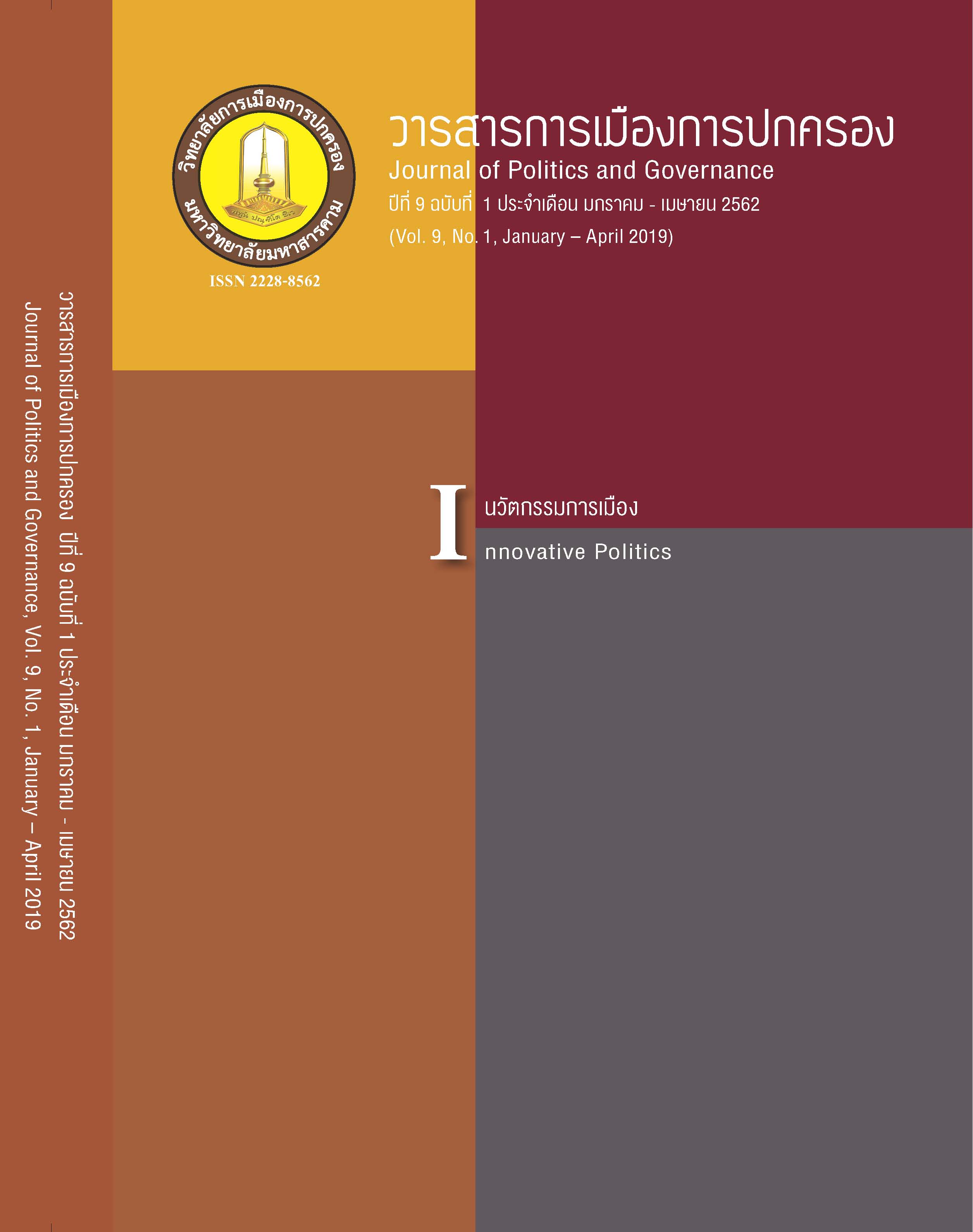A Comparative Study on Anti-Corruption Agencies in Singapore, Hong Kong, and Republic of Korea: Recommendations for Thailand
Main Article Content
Abstract
This article focuses on 1) roles, structures, and working procedures of Anti-Corruption Agencies (ACA) in Singapore, Hong Kong, and Republic of Korea; 2) recommendations to improve the ACAs’ performances of Thailand. Author uses the documentary research as the main methodology for this study. The results show that prominent strategy of Hong Kong’s ACA is the “three-pronged strategy”, which goes along with the simplicity of its organization’s structure designation, effective media utilization, and local participation to fight against corruption. Singapore’s ACA is a centralized, small, and flexible organization with strong and powerful law enforcement. There is also a highly effective anti-corruption mechanism in Singapore which is; strong political wills to deal with corruption, tough law enforcement, public sector efficiency, and independence of ACA. In Republic of Korea, the ACA is merged from related three anti-corruption organizations, and the structure of national ACA’s committee is effective to curb with corruptions in both political and public sectors. There is also a striking dual-corruption assessment system which is effective to interfere the corruption in public sector. However, the creation of local anti-corruption commission (LACC); related public agencies on anti-corruption affairs should be merged, and enhancing the proactive corruption prevention mechanisms, should be useful and effective ways to improve the ACA’s performances in Thailand.
Article Details
References
_____. (2560b). แนวคิดการประเมินคุณธรรม ความโปร่งใส และธรรมาภิบาลในหน่วยงานภาครัฐและเอกชนของต่างประเทศ. เอกสารวิชาการประกอบการศึกษาวิจัยเพื่อพัฒนาประสิทธิภาพและมาตรฐานการประเมินคุณธรรมและความโปร่งใสในการดำเนินงานของหน่วยงานภาครัฐ (ITA) ปี 2560. ขอนแก่น: วิทยาลัยการปกครองท้องถิ่น มหาวิทยาลัยขอนแก่น.
Corrupt Practices Investigation Bureau. (2016a). Roles & Functions. Singapore: CPIB. Retrieved from:https://www.cpib.gov.sg/about-cpib/roles-and-functions (July 7, 2017)
Corrupt Practices Investigation Bureau. (2016b). Organizational Structure. Singapore: CPIB. Retrieved from: https://www.cpib.gov.sg/about-us/our-work/organisational-structure (July 7, 2017)
_____. (2017). PACT: A Practical Anti-Corruption Guide for Businesses in Singapore. Singapore:the CPIB.
Gorta, A. (2006). Corruption Risk Areas and Corruption Resistance. in Sampford, C. & Shacklock, A. & Connors, C. & Galtung, F. Measuring Corruption : Law Ethics and Governance Series. Aldershot: Ashgate Publishing Group.
Government of Hong Kong. (2016). Hong Kong : The Facts of ICAC. Hong Kong: GovHK.
Heibrunn, J., R. (2006). Anti-Corruption Commissions. in Stapenhurst, C. & Johnston, N. & Pelizzo, R. (Eds). The Role of Parliament in Curbing Corruption. Washington D.C.: The World Bank.
Hong Kong e-Legislation. (2008). Independent Commission Against Corruption Ordinance (English Version). Hong Kong: HKEL
_____. (2016). the Elections (Corrupt and Illegal Conduct) Ordinance (English Version). Hong Kong: HKEL.
_____. (2017). the Prevention of Bribery Ordinance (English Version). Hong Kong: HKEL.
Hsieh, Mingl-Li. (2017). A Case Study: Lessons from the Hong Kong Independent Commission Against Corruption. International Journal of Criminology and Sociology, 2017(6), 5-15
ICAC Club. (2016). About the ICAC Club. Hong Kong Independent Commission Against Corruption. Retrieved form: http://www.icac.org.hk/icac/club/en/p1.html (July 7, 2017)
Independent Commission Against Corruption. (2016). Annual Report 2016. Hong Kong: ICAC.
Koh Teck Hin. (2017). National Anti-Corruption Strategy: The Singapore Experience. United Nations Asia and Far East Institute for the Prevention of Crime and the Treatment of Offenders(UNAFEI).
Lee Hsien Loong. (2015). Introduction. in The Corrupt Practices Investigation Bureau. The Corrupt Practices Investigation Bureau Annual Report 2015. Singapore: CPIB.
Quah, J., S.T. (2003). Curbing Corruption in Asia: A Comparative Study of Six Countries. Singapore: Eastern University Press
_____. (2007). Combating Corruption Singapore-Style: Lessons for Other Asian Countries. Maryland: Maryland Series in Contemporary Asian Studies Inc.
_____. (2010). Defying Institutional Failure: Learning from the Experiences of Anti - Corruption Agencies in Four Asian Countries. Crime, Law, and Social Change, 53(1), 23-54.
_____. (2011). Curbing Corruption in the Asian Countries: An Impossible Dream. Bingley : Emerald Group Publishing Limited.
The Anti-Corruption and Civil Rights Commission. (2017). ACRC : Taking A Big Stride Forward on Transparency and Civil Rights. Seoul: Republic of Korea.
The Anti-Corruption and Civil Rights Commission. (2017a). Act on Anti-Corruption and The Establishment and Operation of The Anti-Corruption and Civil Rights Commission. Seoul. Republic of Korea.
Transparency International. (2011). Corruption Perceptions Index 2010. Berlin: TI International Secretariat
_____. (2012). Corruption Perceptions Index 2011. Berlin: TI International Secretariat
_____. (2013). Corruption Perceptions Index 2012. Berlin: TI International Secretariat
_____. (2014). Corruption Perceptions Index 2013. Berlin: TI International Secretariat
_____. (2015). Corruption Perceptions Index 2014. Berlin: TI International Secretariat
_____. (2016). Corruption Perceptions Index 2015. Berlin: TI International Secretariat
Transparency International. (2017). Corruption Perceptions Index 2016. Berlin: TI International Secretariat
World Bank. (2016). Full Dataset (Excel): The Worldwide Governance Indicators 1996–2015. The World Bank Group. Retrieved from: http://info.worldbank.org/ governance/WGI/#home (July 7, 2017).


